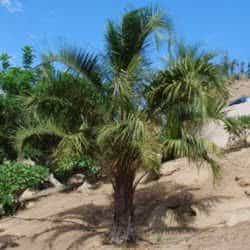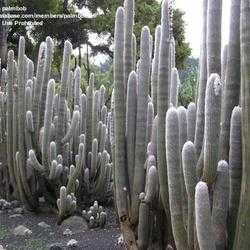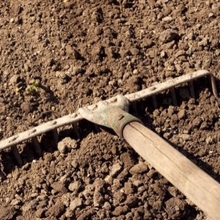This palm, as the name suggests, is native to Chile where it once grew in huge numbers. Today the palm is protected so it's making a comeback, but years of ‘farming' it for its sap, which can be boiled down and fermented into a wine, has decimated the populations. Thankfully it is not currently endangered and reportedly over 100,000 palms exist in Chile. It is a popular palm worldwide and old plants can be found growing in many different continents.
The primary reasons for the popularity of Jubaea chilensis are its massive, monolithic stature, ease of growth and impressive hardiness in the face of cold. This is one of top 20 or so most cold-hardy palms and one can find them growing throughout Europe, Australia, South Africa, and even Canada. One condition this palm does not like, however, is the hot and humid climates most palms seem to favor. I know of a few who are growing this plant in Hawaii and Florida, where it indeed can survive for many years. However, it rarely looks good, particularly as it starts to trunk, and eventually rots. However, in a Mediterranean climate--such as found here in California--it grows quite well, though slow.
 Jubaea chilensis growing in Leu Gardens, Orlando (photo taken in 2003; no longer alive now). You can see how this is a sad version of a normally majestic palm
Jubaea chilensis growing in Leu Gardens, Orlando (photo taken in 2003; no longer alive now). You can see how this is a sad version of a normally majestic palm
Heat itself does not appear to be a major limiting factor, though it does not do well in climates with intense summer heat (like in Arizona), even if the humidity is relatively low. Rainfall is also not a limiting factor and the palms seem to prefer being watered regularly despite being one of the more drought-tolerant palms (once established and mature!) It still needs some soil moisture and its relatively deep roots (for a palm) are always looking for moisture deep in the soil. I have found that the more water these get, the faster they grow, as long as the soil drains well. These palms, typical of many non-crownshafted pinnate-leafed palms, are fairly intolerant of overhead watering and will often succumb to bud rot from this practice. I have rotted a few myself this way. Water these either by drip or low sprinklers/emitters that do not get the crowns wet with tap water.
 Note the lack of crownshaft in this mature adult. By the time Jubaeas get this tall, though, watering the crown is hardly ever an issue.
Note the lack of crownshaft in this mature adult. By the time Jubaeas get this tall, though, watering the crown is hardly ever an issue.
Jubaeas seem to be cold-tolerant down to around 5 F (-15 C) though leaf burn will probably occur if exposed to such temperatures for any prolonged period. And bud rot can result if the burns are bad enough. These palms are not very tolerant of saltwater or salty spray and will look terrible if planted along a beach. Salty water at the root level will usually damage the palms, too, and likely kill them. I have grown this palm in fairly heavy clay soils and they have done quite well as long as they don't sit in standing water for long periods of time.
 Palm growing well in British Columbia (Canada) (photo by Denis_BC)
Palm growing well in British Columbia (Canada) (photo by Denis_BC)
Some books describe this as one of the slowest growing of all palms, but most of these books are written by authors living in Florida or other warm, humid parts of the world where most palms grow rapidly. In Mediterranean climates many palms grow slowly and Jubaeas are far from the slowest growing. In fact, there are far more palms that grow slower than a Jubaea in California than there are faster-growing species. Growth rate is not easy to describe accurately, anyway; is it the rate of new leaf formation, or the rate of overall height increase? Some palms grow fairly rapidly in terms of making new leaves but just don't seem to gain much in height over time despite always making new leaves. Yet one could certainly say this sort of palm is fast growing. Then other palms will just put out 2 or 3 leaves a year but that will be a gain of 1 to 2 feet in overall height. Jubaeas belong to the former group. My seedling Jubaea puts out about one leaf every other month, which is faster than most of the palms I grow in my yard, and at least as fast as my queen palm. But the overall height change of this Jubaea is nearly imperceptible over a year's time, while my Queen and King palms may have grown 1 or 2 feet or more during the same time.
 Jubaea petioles showing how closely space they are. One leaf is produced at a time but they are so closely spaced and around an enormous circumference that the end result is hardly and perceptible upward growth
Jubaea petioles showing how closely space they are. One leaf is produced at a time but they are so closely spaced and around an enormous circumference that the end result is hardly and perceptible upward growth
Some confuse Jubaeas with another more common landscape palm, Phoenix canariensis (Canary Island Date Palm). These are somewhat similar in overall appearance, but are much faster-growing palms, have greener leaves, more prominent leaf scars in trunk, huge, deadly thorns at the leaf bases and the leaves are induplicate, not reduplicate as Jubaea leaves are (see leaf discussion below.)



(left) Two Phoenix canariensis with a Jubaea in between. (middle) Jubaea on right and row of Phoenix on left. (right) Rows of Phoenix canariensis in Los Angeles.
Jubaeas are monoecious palms (i.e., they have both male and female flowers.) This means a single tree can produce fertile seed. Jubaeas can be grown from seed (fresh seed is best) but it can take a good deal of patience; some seeds do not germinate for more than 18 months! I planted some in a seedbox last year and they just sprouted last month--I was sure they were never going to germinate at this point and was about to toss out the whole box. The fruits of the Jubaea are edible, but I don't recommend eating them (sort of a soapy taste). Supposedly the seeds--which are about 1 inch in diameter--taste somewhat like a coconut, but I have not tried one.



(left) Used flower spathes. (middle) Fallen flowers (these are more obviously purple while still in the tree) (right) Unripe (green) and ripe (yellow) fruit.



(left) Fruit on ground. (middle) Fruit showing squirrel damage. (right) Seeds and a fruit of Jubaea.
 seedlings that took about 18 months to germinate
seedlings that took about 18 months to germinate
Little care is needed in the proper climates, once this palm is acclimated. Just water it well and perhaps provide some slow-release palm fertilizer yearly. Few problems other than the bud rot mentioned above afflict this species. The leaves are too thick and stiff for most insects to find tasty. Sun, heat, cold, wind and drought are not huge concerns. It is a fairly easy palm to grow. Young seedlings prefer some protection from hot, arid direct sunshine so some protection may be needed until the palm is forming pinnate leaves.
 Field grown Jubaeas with low-emitter sprinklers
Field grown Jubaeas with low-emitter sprinklers
It can take decades for these palms to start forming a trunk, but once they do, growth rate seems to pick up a bit. And they make a massive trunk! Trunks can grow up to a diameter of 6 feet. I am not sure I have seen one that big, but I've seen them close to that size. That makes it one of the fattest-trunked palms, if not the fattest. These palms can grow over 80 feet tall though a palm that tall would probably be over 100 years old. So if you are starting with fresh seed it is unlikely you will live long enough to see your palm tower over your house or certainly not the nearby telephone poles. Trunks are smooth with the leaves falling off as they die (no retained leaf bases that so many other palms keep) and the color is a deep grey. Some trunks develop a bulge in the middle, and most old palms tend to have a tapering of the trunk diameter, often suddenly, sort-of like shoulders sloping into a neck. If you look closely at the trunks, you can see the diamond-shaped scars left by the fallen leaves, but far away the effect is a smooth, featureless solid grey cement column. Matures palms are truly majestic, imposing plants and make fantastic landscape trees. They look particularly nice planted in rows creating the effect of large Roman columns.

 early trunk and mature trunk
early trunk and mature trunk


trunk close up showing recent leaf scars; old palm showing 'shoulders' of upper trunk
 Old majestic palms with people in lower right corner for scale
Old majestic palms with people in lower right corner for scale
This is a pinnate or feather-leaved palm. Seedlings retain simple leaves for the first 2 to 3 years and then become pinnate. The leaves are reduplicate (V-shape of leaflet cross section is facing down towards the soil) and are stiff and deep green. Older palms may eventually develop a glaucous blue sheen to the leaves, and some believe these ‘blue Jubaeas' should even be considered a separate subspecies. More likely this blue color either represents normal variation in the population, or it may represent some Butia genes getting in the mix. Butia X Jubaea is a common and popular hybrid with increased vigor in terms of rate of growth as well as hardiness to humidity. These are very popular and sought-after hybrids. Jubaeas vary not only in leaf color, but also in leaf shape and orientation. Some individuals form an almost ‘shuttlecock' shape with the leaves growing almost straight up. Others have relatively straight leaves that project out in all directions creating a somewhat globoid silhouette and still others have markedly recurved leaves (perhaps that Butia gene creeping in again?)



(left) Seedling Jubaea about 4 to 5 years old. (middle) 8-year old seedling . (right) Close up leaf showing reduplicate orientation.



(left) Arching leaves half-crown (not trimmed to do this) (middle) Shuttlecock form. (right) Basic straight-stiff-leaf form

 'Blue' form of Jubaea
'Blue' form of Jubaea



(left and middle) Butia X Jubaeas in public gardens (right) Jubaea in front of and to the right of a Butia x Jubaea
Once it has groown to maturity, this palm is one of the more tolerant of being moved, as long as the trunk is not bent or damaged. Large old palms can be worth many thousands of dollars. Though not a quick turnaround on your investment, this is palm one that an owner can usually easily sell someday and often for a lot of money. That is something that cannot be said about too many other palms.

 Growing in public gardens with very little care
Growing in public gardens with very little care
Perhaps this palm is a bit large for the average yard, but if you have room for it and the right climate, this could be an awesome landscape palm. And remember it grows fairly slowly, so perhaps ultimate size should not be a consideration, though it might for your children at some point.

















